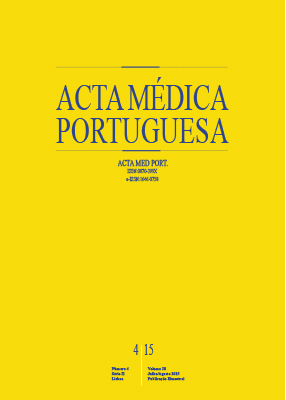Bundle Approach to Reduce Bloodstream Infections in Neutropenic Hematologic
DOI:
https://doi.org/10.20344/amp.6002Keywords:
Catheter-Related Infections, Catheterization, Central Venous, Neutropenia.Abstract
Introduction: The objective of the study was to reduce, by a bundle of interventions, the global bloodstream infections and catheterrelated bloodstream infections rates in neutropenic hematology patients with a long-term central venous catheter.
Material and Methods: This was a non-randomized prospective study. It was conducted in a 20-bed hematology oncology unit (Portuguese Institute of Oncology, Porto, Portugal) between 1st of August 2010 and 31st of January 2012. In this period we introduced a bundle of interventions (study group) and compared the results with the six months prior to implementation (control group). The interventions consisted in the use of a neutral pressure mechanical valve connector instead of a positive pressure mechanical valve connector, a more frequent change of this connector and a more efficient clean solution. One hundred and sixteen hematology patients with a long-term central venous catheter at time superior of 72 h, with 8 867 central venous catheter days [6 756 central venous catheter days in the study group and 2 111 central venous catheter days in the control group] were included in the study.
Results: A significant reduction in bloodstream infections rates and catheter-related bloodstream infections rates was achieved. Bloodstream infections rates: [32.69 (control group) vs. 9.43 (study group)], incidence reduction 71% [relative risk 0.2886, CI 95% (0.1793 – 0.4647), p < 0.001] and catheter-related bloodstream infections rates: [17.53 (control group) vs. 4.73 (study group)], incidence reduction 71% [relative risk 0.2936, CI 95% (0.1793 – 0.5615), p < 0.014]. No significant difference (p > 0.05) was found in the neutrophil count at the time of blood culture samples between groups: 69% (< 500 neutrophils/mm3) [71% (study group) vs. 68% (control group)].
Conclusions: The introduction of this bundle of interventions based on the variables of patient, product and practice, supported by the Healthcare and Technology Synergy framework, quickly resulted in a significant reduction of bloodstream infections and catheterrelated bloodstream infections rates.
Downloads
Downloads
Published
How to Cite
Issue
Section
License
All the articles published in the AMP are open access and comply with the requirements of funding agencies or academic institutions. The AMP is governed by the terms of the Creative Commons ‘Attribution – Non-Commercial Use - (CC-BY-NC)’ license, regarding the use by third parties.
It is the author’s responsibility to obtain approval for the reproduction of figures, tables, etc. from other publications.
Upon acceptance of an article for publication, the authors will be asked to complete the ICMJE “Copyright Liability and Copyright Sharing Statement “(http://www.actamedicaportuguesa.com/info/AMP-NormasPublicacao.pdf) and the “Declaration of Potential Conflicts of Interest” (http:// www.icmje.org/conflicts-of-interest). An e-mail will be sent to the corresponding author to acknowledge receipt of the manuscript.
After publication, the authors are authorised to make their articles available in repositories of their institutions of origin, as long as they always mention where they were published and according to the Creative Commons license.









